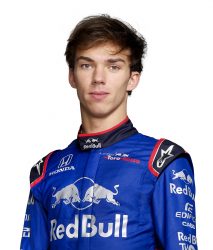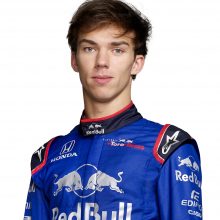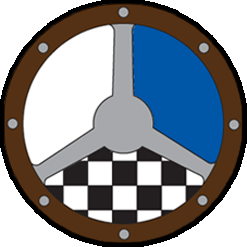Ask a pro
Receive advice directly from today’s top stars


Pierre Gasly
Toro Rosso driver and former GP2 champion
Toro Rosso F1 driver and former GP2 champion Pierre Gasly is the latest online driving instructor for SAFEisFAST.com.
Gasly is competing in his first full season of F1 with Toro Rosso ahead of a move to Red Bull Racing in 2019, where he will partner Max Verstappen.
The Frenchman has been a part of the Red Bull junior programme since 2014 when he was racing in Formula Renault 3.5, following years of karting and junior-series racing in France.
Gasly currently sits P13 in the 2018 standings with a handful of strong qualifying rounds and a best race position finish of fourth at the Bahrain Grand Prix.
Pierre Gasly answers your questions!
-
Adam G
Hi Pierre. I am 19 and racing is a passion of mine, but where and how do I start a professional racing career?




I think the best way to start at 19 years old is always Formula 4 to learn the basic things about driving and then after try the normal series after and climb the ladders and see where you end up.
-
Brad Dias
For a young driver who wants to race in single-seaters like Formula 2 or Super Formula, could you explain how they compare physically to a Formula 1 car?




So, of course they are easier in some ways because they don’t go fast in Super Formula and Formula 2 as in F1, so you don’t get the g-forces. F2 is pretty physical for the upper body because you don’t have any power steering assistance compared to F1, so yeah it’s pretty tough for the shoulders and the upper body. Super Formula races are pretty long, pretty close to one hour 20 minutes, so quite close to F1, but in the end nothing is as physical as the new F1 cars with all the g-forces we have. But yeah, the others you have to still be well prepared because they are fast cars and challenging to drive.
-
Mirjam Kraak
Congratulations on your move to Red Bull next year, it will be exciting to be in a team with Max Verstappen. My question is, I know about how physical the modern F1 cars are to drive, but how important is the mental side of the sport?




The mental side plays a big part. I think it’s like in all the other sports, you’ve got to be strong mentally and ready to face all kinds of situations, and of course as an athlete there is never any story without a struggle, so you have to be really, really strong mentally to go through all this. You have ups and downs but you have to be ready to bounce back all the time, that’s part of the sport all the time, but clearly it’s as important as the physical side of the sport.
-
Marc Cohn
What do you feel has been the key to maximize your performance to achieve those amazing finishes this year at Bahrain and Hungary?




Just focusing on each single detail. Whether it’s on track or off track and each single thing we can affect on the car and each preparation. There are so many parameters to get the best performance and out of the package, especially at such a high level where everyone is so talented, so to really make the difference you need to focus on every single detail.
-
Tyler Dylan
Given their recent progress at Toro Rosso, do you think you will be able to win a race in a Honda-powered car next year?




I really hope so. Of course next year there is a change of regulation so we still need to see our performance with the new aero regulations at Red Bull, but yeah I think that Honda is really progressing and going in the right direction. They have a good plan of development for the coming months and if we have a good car – and Red Bull always makes a good car – then hopefully we will be in a good position to fight for wins sometimes.
-
AJ Velazquez
The speeds in F1 cars are so extreme and the braking distances so short, how do you pick your braking points and do they change over the course of the weekend?




You better be sharp when you drive the car, because for sure yeah in the space of a tenth of a second you do a lot of metres. Basically you have braking marks, with the boards, or the kerbs, or with lines, asphalt, pieces of asphalt…basically every little thing that you can see around the track or on your braking point is useful, and then after it’s also about the feeling and how late you can brake and how much potential you have from the car to really be on the limit of the locking.
-
Seb Haughton
Do you think that Formula E will get as popular as Formula 1 one day?




I think it will be really, really big and I see a bright future for them, and I think everything they are doing looks to be good and exciting and always improving, but I think that F1 will always stay at the top and the main series in motorsport.
-
Sam Walsh
Besides yourself, who do you think is the quickest driver in the young driver ranks?




It’s difficult to compare drivers with different cars and everything, but I would still probably say Max who is really, really high for his age and has the best results so far in F1. I think everyone is at about the same level so it’s difficult to compare, but probably Max.
-
Christopher Michael
What is your favourite memory of racing?




Favourite memory of racing is either my 4th place in Bahrain or the victory in Abu Dhabi that got me really close to the championship or the feeling of winning the championship in F2.
-
Ryan Vargas
How does a driver develop raw speed?




I think a lot of it is talent and something that you feel, and then after it’s more about experience and how you learn, and how you drive in karting and after the feeling you get in Formula 4 and so on. Repetition, like in any sport, the more you repeat things, the more automatic they become. And then after that is practice on the simulator and all the other cars you can drive, they’re all useful.
 Road Racing Drivers Club
Road Racing Drivers Club
 Share
Share







